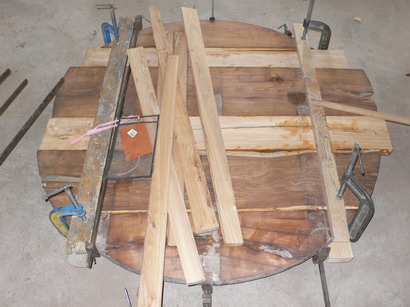Mixing Wood Species in a Tabletop
Wood moisture content is more important than wood species for controlling movement. May 13, 2009
Question
I've had this discussion with a woodworker. He was making a round table top (see picture below) out of (100 year old wood), but replaced some of the planks with new ones. The old planks are a harder wood like good elm or walnut, while the new planks are pine (light wood). Checking the moisture content, I find they are "almost similar" 10 to 12%. The rule is never glue planks of different MC next to each other as it will split. What if the difference in MC is acceptable, but the woods are different? (I think it will also split). Can anyone give his/her opinion and share experiences?

Click here for higher quality, full size image
Forum Responses
(Furniture Making Forum)
From contributor D:
If the MC was down at furniture grade levels which is 6% - 8% MC then I would see no reason there is a problem as long as the top has not been cross cleated on the back in such a way as to prevent the natural movement of the wood from happening, or some other process of assembly in constructing the table that restrains the woods movement. I think the M.C. you have of 10% -12% is high. If the lumber was sound without end checks at the time of assembly, I see no reason for it to start at that MC. I think the bigger problem at that MC will be keeping the top flat as it dries down to 6-8%.
From contributor R:
I would use woods close in density and strength - maple and cherry. I would not use anything that has a significant difference, pine and walnut. They will sand and finish differently and there both will be subject to the same kind of stress and will handle them differently.
From Gene Wengert, forum technical advisor:
Wood only changes size or shape in use for one reason - its MC is changing. So, if you dry it to the same MC that it will have in use, it will not change size and you can mix wood species. Of course, the real world has changes in MC from wintertime to summertime, so some movement will be expected. Choose a MC between the two extremes (often 7.0% MC) and you will have a little shrinkage in the winter and a little swelling in the summer. Hopefully, a "little" will not be a problem. A good finish that restricts vapor movement will slow any moisture changes and help minimize problems too.
From the original questioner:
The conclusion is that it can be ok to use different woods glued next to each other, as long as their density is not too different, so that they will expand and contract in more or less the same amount. We will also use strong dovetail connected beams on the back.
From Gene Wengert, forum technical advisor:
The beams might actually prevent the back from moving (if the MC changes) and would not be a good idea. It is better to design them with slotted screw holes so that the piece can move a bit. In any case, get the MC correct.
